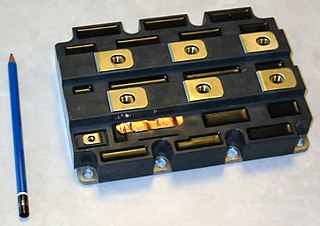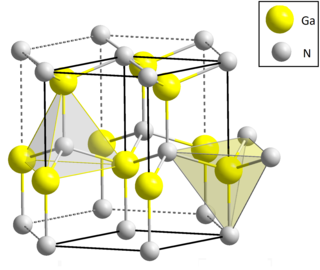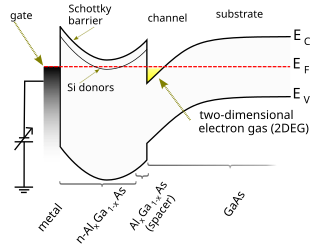Related Research Articles

A transistor is a semiconductor device used to amplify or switch electrical signals and power. It is one of the basic building blocks of modern electronics. It is composed of semiconductor material, usually with at least three terminals for connection to an electronic circuit. A voltage or current applied to one pair of the transistor's terminals controls the current through another pair of terminals. Because the controlled (output) power can be higher than the controlling (input) power, a transistor can amplify a signal. Some transistors are packaged individually, but many more in miniature form are found embedded in integrated circuits. Because transistors are the key active components in practically all modern electronics, many people consider them one of the 20th century's greatest inventions.
A semiconductor device is an electronic component that relies on the electronic properties of a semiconductor material for its function. Its conductivity lies between conductors and insulators. Semiconductor devices have replaced vacuum tubes in most applications. They conduct electric current in the solid state, rather than as free electrons across a vacuum or as free electrons and ions through an ionized gas.

An insulated-gate bipolar transistor (IGBT) is a three-terminal power semiconductor device primarily forming an electronic switch. It was developed to combine high efficiency with fast switching. It consists of four alternating layers (P–N–P–N) that are controlled by a metal–oxide–semiconductor (MOS) gate structure.

Gallium arsenide (GaAs) is a III-V direct band gap semiconductor with a zinc blende crystal structure.

Gallium nitride is a binary III/V direct bandgap semiconductor commonly used in blue light-emitting diodes since the 1990s. The compound is a very hard material that has a Wurtzite crystal structure. Its wide band gap of 3.4 eV affords it special properties for applications in optoelectronic, high-power and high-frequency devices. For example, GaN is the substrate which makes violet (405 nm) laser diodes possible, without requiring nonlinear optical frequency-doubling.
A power semiconductor device is a semiconductor device used as a switch or rectifier in power electronics. Such a device is also called a power device or, when used in an integrated circuit, a power IC.

A high-electron-mobility transistor, also known as heterostructure FET (HFET) or modulation-doped FET (MODFET), is a field-effect transistor incorporating a junction between two materials with different band gaps as the channel instead of a doped region. A commonly used material combination is GaAs with AlGaAs, though there is wide variation, dependent on the application of the device. Devices incorporating more indium generally show better high-frequency performance, while in recent years, gallium nitride HEMTs have attracted attention due to their high-power performance. Like other FETs, HEMTs are used in integrated circuits as digital on-off switches. FETs can also be used as amplifiers for large amounts of current using a small voltage as a control signal. Both of these uses are made possible by the FET’s unique current–voltage characteristics. HEMT transistors are able to operate at higher frequencies than ordinary transistors, up to millimeter wave frequencies, and are used in high-frequency products such as cell phones, satellite television receivers, voltage converters, and radar equipment. They are widely used in satellite receivers, in low power amplifiers and in the defense industry.

Power electronics is the application of electronics to the control and conversion of electric power.

A power MOSFET is a specific type of metal–oxide–semiconductor field-effect transistor (MOSFET) designed to handle significant power levels. Compared to the other power semiconductor devices, such as an insulated-gate bipolar transistor (IGBT) or a thyristor, its main advantages are high switching speed and good efficiency at low voltages. It shares with the IGBT an isolated gate that makes it easy to drive. They can be subject to low gain, sometimes to a degree that the gate voltage needs to be higher than the voltage under control.

A VMOS transistor is a type of MOSFET. VMOS is also used for describing the V-groove shape vertically cut into the substrate material. VMOS is an acronym for "vertical metal oxide semiconductor", or "V-groove MOS".

International Rectifier was an American power management technology company manufacturing analog and mixed-signal ICs, advanced circuit devices, integrated power systems, and high-performance integrated components for computing. On 13 January 2015, the company became a part of Infineon Technologies.
SONOS, short for "silicon–oxide–nitride–oxide–silicon", more precisely, "polycrystalline silicon"—"silicon dioxide"—"silicon nitride"—"silicon dioxide"—"silicon", is a cross sectional structure of MOSFET (metal–oxide–semiconductor field-effect transistor), realized by P.C.Y. Chen of Fairchild Camera and Instrument in 1977. This structure is often used for non-volatile memories, such as EEPROM and flash memories. It is sometimes used for TFT LCD displays. It is one of CTF (charge trap flash) variants. It is distinguished from traditional non-volatile memory structures by the use of silicon nitride (Si3N4 or Si9N10) instead of "polysilicon-based FG (floating-gate)" for the charge storage material. A further variant is "SHINOS" ("silicon"—"hi-k"—"nitride"—"oxide"—"silicon"), which is substituted top oxide layer with high-κ material. Another advanced variant is "MONOS" ("metal–oxide–nitride–oxide–silicon"). Companies offering SONOS-based products include Cypress Semiconductor, Macronix, Toshiba, United Microelectronics Corporation and Floadia.
A transistor is a semiconductor device with at least three terminals for connection to an electric circuit. In the common case, the third terminal controls the flow of current between the other two terminals. This can be used for amplification, as in the case of a radio receiver, or for rapid switching, as in the case of digital circuits. The transistor replaced the vacuum-tube triode, also called a (thermionic) valve, which was much larger in size and used significantly more power to operate.The first transistor was successfully demonstrated on December 23, 1947, at Bell Laboratories in Murray Hill, New Jersey. Bell Labs was the research arm of American Telephone and Telegraph (AT&T). The three individuals credited with the invention of the transistor were William Shockley, John Bardeen and Walter Brattain. The introduction of the transistor is often considered one of the most important inventions in history.
The Compact Model Coalition is a working group in the Electronic Design Automation industry formed to choose, maintain and promote the use of standard semiconductor device models. Commercial and industrial analog simulators need to add device models as technology advances and earlier models become inaccurate. Before this group was formed, new transistor models were largely proprietary, which severely limited the choice of simulators that could be used.

Vishay Intertechnology, Inc. is an American manufacturer of discrete semiconductors and passive electronic components founded by Polish-born businessman Felix Zandman. Vishay has manufacturing plants in Israel, Asia, Europe, and the Americas where it produces rectifiers, diodes, MOSFETs, optoelectronics, selected integrated circuits, resistors, capacitors, and inductors. Vishay Intertechnology revenues for 2022 were $3.5 billion. As of December 31, 2022, Vishay Intertechnology had approximately 23,900 full-time employees.

MACOM Technology Solutions is a developer and producer of radio, microwave, and millimeter wave semiconductor devices and components. The company is headquartered in Lowell, Massachusetts, and in 2005 was Lowell's largest private employer. MACOM is certified to the ISO 9001 international quality standard and ISO 14001 environmental standard. The company has design centers and sales offices in North America, Europe, Asia and Australia.

The field-effect transistor (FET) is a type of transistor that uses an electric field to control the flow of current in a semiconductor. FETs are devices with three terminals: source, gate, and drain. FETs control the flow of current by the application of a voltage to the gate, which in turn alters the conductivity between the drain and source.
Umesh K. Mishra is a professor in the Electrical & Computer Engineering Department at the University of California, Santa Barbara (1990–Present). In 2023, he was appointed dean of the UC Santa Barbara College of Engineering. He is the CTO, co-founder and board member of Transphorm, founded in 2007 and the first company to deliver gallium nitride (GaN) transistor products for high efficiency power conversion technologies. Prior to Transphorm, he co-founded Nitres Inc. in 1996, which was the first company to develop GaN LEDs and transistors.
Efficient Power Conversion (EPC) is a semiconductor company that produces transistors and integrated circuits based on gallium nitride (GaN). The company was founded in 2007 by Alex Lidow, Joe Cao and Robert Beach, with Lidow continuing as CEO. The company is based in El Segundo, California. Its eGaN® FETs and ICs are widely used in the Light Detection and Ranging (Lidar) systems for self-driving and autonomous vehicles, such as the lidar systems developed by Velodyne. In 2020, the company entered into a joint venture with VPT to form EPC Space which provides radiation-hardened GaN devices for space applications.

Srabanti Chowdhury is an Indian American Electrical Engineer who is an associate professor of electrical engineering at Stanford University. She is a senior fellow of the Precourt Institute for Energy. At Stanford she works on ultra-wide and wide-bandgap semiconductors and device engineering for energy-efficient electronic devices. She serves as Director for Science Collaborations at the United States Department of Energy Energy Frontier Research Center ULTRA.
References
- 1 2 Triangulation (2017-10-27), Triangulation 319: Our Friend Gallium Nitride , retrieved 2017-10-29
- ↑ “SEMI Award For North America” Archived 2016-08-05 at the Wayback Machine semi.org
- ↑ “Reciprocal Trade and Investment Act” Senate.gov. 1983-03-04. Retrieved 2016-08-12
- ↑ “Patents by Alexander Lidow” Justia Patents. Retrieved 2016-08-17
- ↑ Rogers,Bruce “Alex Lidow's Quest To Replace Silicon And Revolutionize Electronics” Forbes.com. 2015-09-03. Retrieved 2016-08-12
- ↑ “Best Managed Companies in America: Turbocharged” Forbes.com. 2005-01-10. Retrieved 2016-08-12
- ↑ Toback, Steve “Look Out Silicon Valley, Here Comes Gallium Beach” FoxBusiness.com. 2016-03-18. Retrieved 2016-08-12
- ↑ Clarke, Peter “International Rectifier sues former CEO Alex Lidow” EETimes.com. 2009-01-19. Retrieved 2016-08-12
- ↑ “Alexander Lidow v. The Superior Court of Los Angeles County International Rectifier Corp” FindLaw.com. 2012-05-23. Retrieved 2016-08-12
- ↑ Lidow, Alex, Strydom, Johan, de Rooij, Michael, Reusch, David “GaN Transistors for Efficient Power Conversion, 2nd Edition” Wiley
- ↑ “Alex Lidow – Google Scholar Citations” Scholar.Google.com. Retrieved 2016-08-17
- ↑ “Hertz Foundation Fellows” Retrieved 2016-08-12
- ↑ “Alexander Lidow Elected to Caltech Board of Trustees” Caltech.edu. 1998-08-27. Retrieved 2016-08-12
- ↑ “AMENDMENT NO. 2 TO FORM S-3 REGISTRATION STATEMENT UNDER THE SECURITIES ACT OF 1933” Nasdaq.com. 2000-03-07. Retrieved 2016-08-12